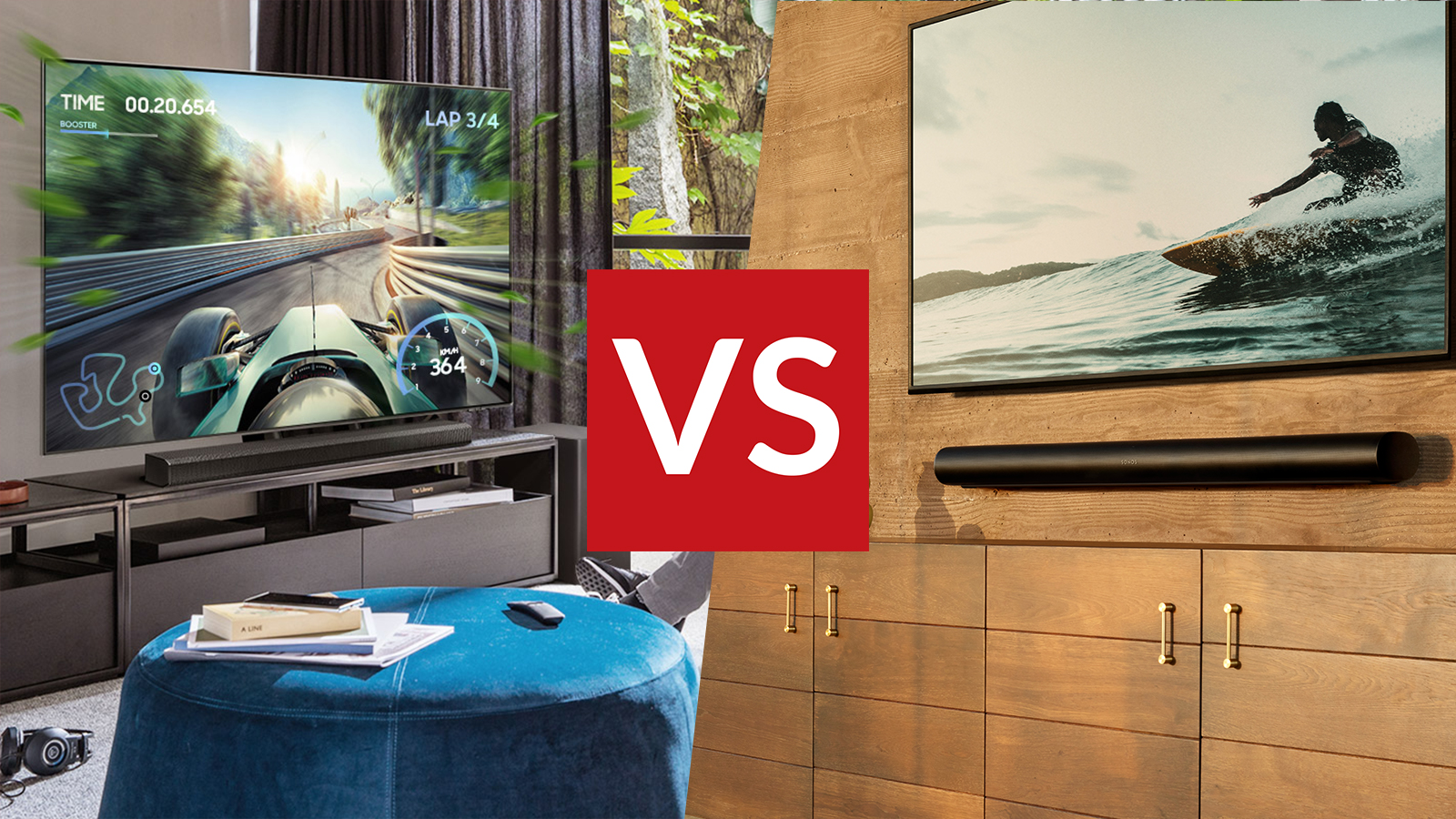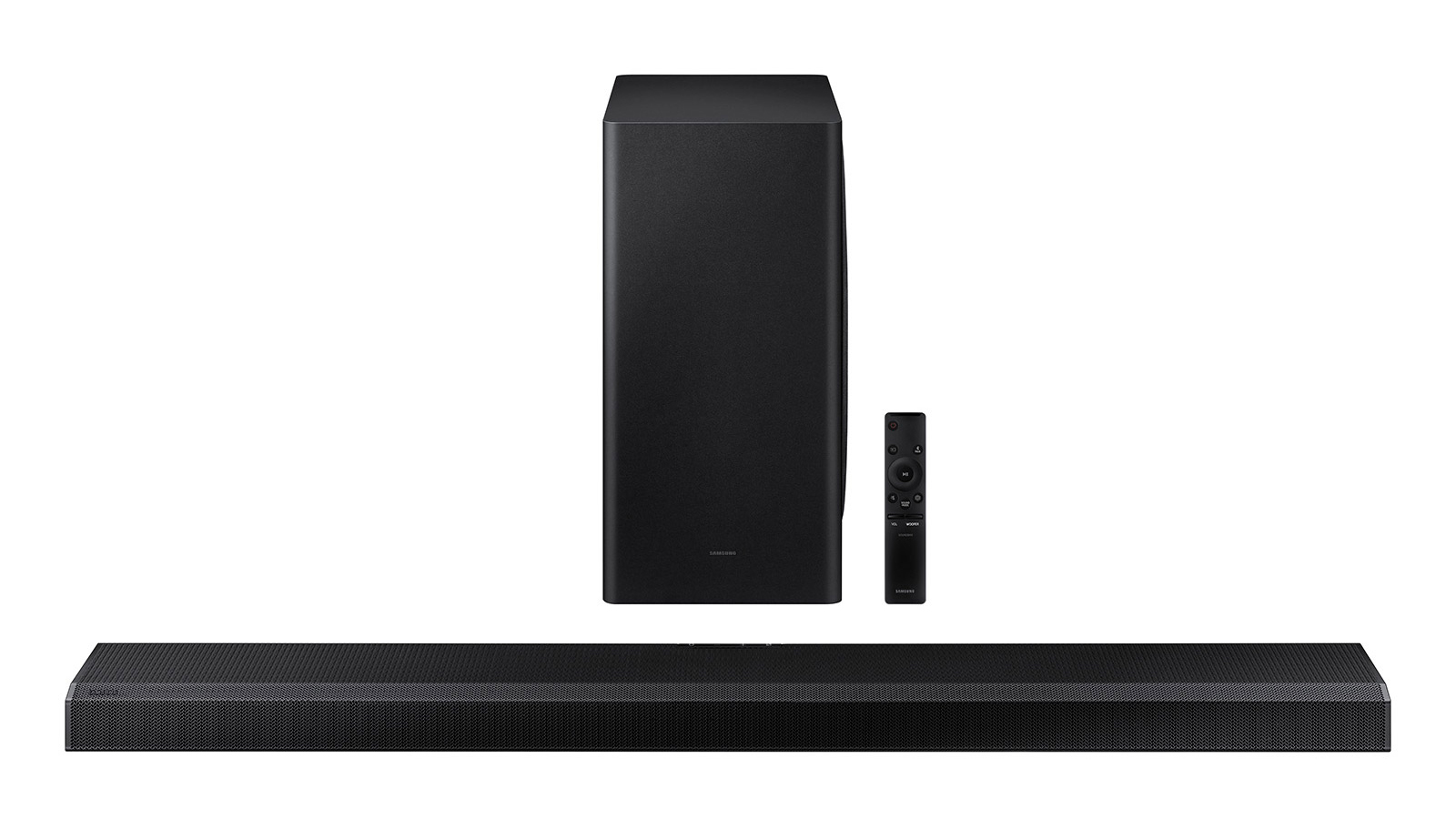
If you're looking for a Dolby Atmos soundbar, you'll likely find yourself wondering about the Samsung HW-Q800A vs Sonos Arc – these are two top soundbars with directional 3D sound and impressive feature lists (there's also the newer Q800B replacement, which now positions the older 800A at an even better price point).
The Samsung HW-Q800A is (unsurprisingly) one of the best soundbars for Samsung TVs, but it's a great-looking buy no matter what company your TV made by. The Sonos Arc, meanwhile, has held a high place in our guide to the best soundbars since its launch, thanks to its superb sound quality.
You can read our full Sonos Arc review for more on what we think of its audio quality, but here we're going compare what the Samsung HW-Q800A and Sonos Arc offer. Either is a great pairing for the world's best TVs, so you can decide which one will be the better fit for your living room.
Samsung HW-Q800A vs Sonos Arc: Price & release date
The Samsung HW-Q800A was released in April 2021, costing £799/$799 at launch. Samsung products regularly get discounts over their lifetime, which is exactly what's happened thanks to the arrival of the Q800B follow-up model: you can now buy the older for less.
The Sonos Arc matches the opening asking price at £799/$799/AUD$1,399. The Arc was released in June 2020, and like all Sonos products, has had very little in the way of discounts, so remains at pretty much this price. That makes the Samsung perhaps even more tempting, unless you're a staunch Sonos devotee.
Samsung HW-Q800A vs Sonos Arc: Features & design
Both of these soundbars are designed to be easy audio upgrades for fairly large TVs. The Sonos Arc's 1142mm width means you'll want to pair it with the best 55-inch TVs and up, while the 980mm width of the Samsung HW-Q800A can work with the best 48, 49 and 50-inch TVs and up.
Both aim to bring convincing directional sound from just beneath your TV. We'll talk about how they do that more in the next section, but the brief overview is that the Sonos Arc feature more speakers targeted towards directional sound, but the Samsung HW-Q800A includes a subwoofer.
Get all the latest news, reviews, deals and buying guides on gorgeous tech, home and active products from the T3 experts
Both soundbars support Dolby Atmos 3D audio, but only the Samsung supports DTS:X as well (used on some Blu-rays).
Both soundbars connect to your TV over HDMI ARC or eARC, or they also both have optical audio inputs. But here's a really key difference: the Samsung HW-Q800A has an HDMI input as well as an HDMI output, meaning that it can pass 4K HDR video through to your TV, but takes the audio directly on its way. This is really useful if your TV doesn't support Dolby Atmos, because you can plug a streaming box into the soundbar and bypass the need for the TV to support Atmos support entirely.
The Sonos Arc just has a single HDMI port, which means that if your TV doesn't support Atmos, you may not get the full audio effect (though the Arc will still do its best to upscale more regular surround sound to take full effect of its speakers).
Both soundbars have Alexa built-in, so can operate as smart speakers, effectively. The Sonos Arc also offers Google Assistant support, though.
Both soundbars include Wi-Fi connectivity, and have Apple AirPlay 2 streaming support. The Sonos Arc also works with Sonos' multi-room system, of course, whereas the Samsung includes Bluetooth connectivity to stream from any device.

The Sonos Arc has a sleek design, available in white or black.
Samsung HW-Q800A vs Sonos Arc: Audio
The Sonos Arc uses 11 speaker drivers to deliver what Sonos suggests is 5.0.2 channels of sound – basically, it bounces sound around the room to try to create five surround channels, with two height channels for Atmos. As you can tell from the numbers, there's no subwoofer involved here.
Samsung rates the HW-Q800A as being 3.1.2 channels, created by eight speakers. So it's angling sound to the left, centre and right, plus two upfiring channels for Atmos, and it has a dedicated subwoofer.
The subwoofer is one of the key differences here. The Samsung includes one, and the Sonos Arc doesn't. You can add the Sonos Sub to use with the Arc, but it's a hell of a price increase: £699/$699/AU$999.
The Sonos Arc is still very effective with bass sounds without a subwoofer, but there's no question that a real sub makes a noticeable difference to a home cinema system. It's not about it adding huge room-shaking explosions (though if that's what you want, a sub is definitely essential), but even listening at more reasonable volumes, a sub is capable of lower frequencies, so you're hearing more of how the soundtrack is intended to be.
However, the Sonos Arc does include room calibration (for iPhone users only), which means that you can use the Sonos app to have the soundbar analyse the shape of your room, and optimise its audio output, so you really make the most of its many speakers.
So when it comes to audio, what you're really looking at here is the finesse of the Sonos' extra channels and calibration options, vs the power of the Samsung's subwoofer.
The Samsung does have another trick up its sleeve, though: Q Symphony. This means that if it's connected to a compatible Samsung TV, the soundbar and TV speakers will be used in conjunction with each other for an even bigger soundstage. It's clever stuff, for those all-in on Samsung.

The Samsung HW-Q800A comes with a wireless subwoofer, for easy setup.
Samsung vs Sonos
We've already mentioned a few ways that both of these products can be at their best when they work with other products within their ecosystem. In the case of the Samsung soundbar, it's that certain Samsung TVs enable it to improve its sound even further. In the case of the Sonos Arc, it's that you can use it as part of a Sonos multi-room system.
But there's something else too – both companies also offer additional speakers you can add, to make your experience 'truly' surround. The Samsung Rear Wireless Speaker Kit adds… well, two rear wireless speakers. This will give you a 5.1.2 system when combined with the HW-Q800A.
Similarly, you can use two Sonos One speakers as rear speakers in combination with the Sonos Arc, and we've already mentioned that you can add Sonos' sub for extra bass.
Both companies sell other soundbar options too. Samsung's range from more budget options such as the Samsung HW-S60T up to the elite Samsung HW-Q950T. Sonos just has one other soundbar: the Sonos Beam, which is smaller and cheaper.
Samsung HW-Q800A vs Sonos Arc: Conclusion
Though these share so many of the same key features, they have subtle differences that might make one more suitable for you than the other. For a start, the Sonos Arc is wider than TVs smaller than 55 inches, so any smaller than that and you'll want the Samsung instead. But if your TV is 65 inches and up, we'd probably recommend the extra width of the Sonos.
If your TV doesn't include Dolby Atmos support, you may again need to consider the Samsung, because it includes that 4K HDMI passthrough. And if you don't think a sound system is complete without a sub, only the Samsung includes one.
The Sonos Arc is just as skilled with music as movies, so if you'd also like to use it as a speaker in a multi-room music system, it's probably the better choice (and definitely if you already have Sonos speakers!). But if movies are you focus only, the extra DTS:X support of the Samsung is a bonus.
Plus, with updated pricing, the Samsung bests the Sonos in how much you'll need to pay. That, in addition to its variety of features, makes it the more obvious go-to buy.

Matt is T3's former AV and Smart Home Editor (UK), master of all things audiovisual, overseeing our TV, speakers and headphones coverage. He also covered smart home products and large appliances, as well as our toys and games articles. He's can explain both what Dolby Vision IQ is and why the Lego you're building doesn't fit together the way the instructions say, so is truly invaluable. Matt has worked for tech publications for over 10 years, in print and online, including running T3's print magazine and launching its most recent redesign. He's also contributed to a huge number of tech and gaming titles over the years. Say hello if you see him roaming the halls at CES, IFA or Toy Fair. Matt now works for our sister title TechRadar.
